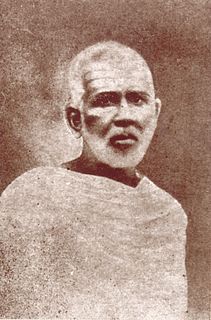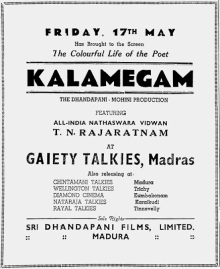Related Research Articles

Tamil literature refers to the literature in the Tamil language. Tamil literature has a rich and long literary tradition spanning more than two thousand years. The oldest extant works show signs of maturity indicating an even longer period of evolution. Contributors to the Tamil literature are mainly from Tamil people from South India, including the land now comprising Tamil Nadu, and the Sri Lankan Tamils from Sri Lanka, as well as the Tamil diaspora. The history of Tamil literature follows the history of Tamil Nadu, closely following the social, political and cultural trends of various periods. The early Sangam literature,, contain anthologies of various poets dealing with many aspects of life, including love, war, social values and religion. This was followed by the early epics and moral literature, authored by Hindu, Jain and Buddhist authors, lasting up to the 5th century CE. From the 6th to 12th century CE, the Tamil devotional poems written by Nayanmars and Alvars, heralded the great Bhakti movement which later engulfed the entire Indian subcontinent. It is during this era that some of the grandest of Tamil literary classics like Kambaramayanam and Periya Puranam were authored and many poets were patronized by the imperial Chola and Pandya empires. The later medieval period saw many assorted minor literary works and also contributions by a few Muslim and European authors.

Ettayapuram is a panchayat town in Thoothukudi district of Tamil Nadu, India. It is the birthplace of Tamil poets Mahakavi Bharathiar and Umaru Pulavar. Muthuswami Dikshitar, one of the triad of Carnatic music was patronized in his final years by the ruler of Ettayapuram.
Karmegha Konar was a popular Tamil poet and educator. He is colloquially known as Chennaa Pulavar, a title given to him by his peer and close friend Bharathidasan.
Annamalai Reddiyar or Reddiar (1865–1891) was a Tamil poet an composer.
Sri Lankan Tamil literature or Ceylon Tamil literature refers to Tamil literature produced in the current day country of Sri Lanka by various Tamil speaking communities such as the Sri Lankan Tamils, Indian Tamils of Sri Lanka and Sri Lankan Muslims. The earliest extant records survived from the Sangam age academies and continued in the medieval era in the courts of the Jaffna kingdom until modern times. The destruction of the Saraswathy Mahal library of Nallur and the burning of Jaffna library led to the loss of a large tract of Sri Lankan Tamil literature, although much survives through oral traditions and the unearthing and preservation of palm-leaf manuscripts, copper plate inscriptions & stone inscriptions.

Chunnakam Kumaraswamy Pulavar was a well-known Sri Lankan Tamil scholar and poet from Maylani village in Chunnakam township in Jaffna peninsula in the British held Ceylon now known as Sri Lanka. He lived from 1854 to 1922. He along with other activists were instrumental in the revival of native traditions in Sri Lanka that had been long dormant during the previous 400 years of colonial rule by various European powers.
Umaru Pulavar was a Tamil Muslim poet from Tamil Nadu, India. Umaru Pulavar was born in 1642 in the town of Nagalapuram in Thoothukudi district. He is celebrated as one of the greatest Islamic poets of India.
Pulavar K. Govindan was a writer, historian, rationalist and politician. He was an elected Member of the Legislative Assembly of Madras State and later, the state of Tamil Nadu. He served as the Deputy Speaker of the Madras Legislative Assembly from 1967 to 1968 and Speaker for two terms from 1969 to 1971 and 1973 to 1977. He has written extensively on Tamil literature and his works were nationalized by the Tamil Nadu State Government in 2007.

Kalamegam is a 1940 Tamil-language film directed by Ellis R. Dungan and starring Nadaswaram player T. N. Rajarathnam Pillai. This was the second film as script writer for the Tamil rationalist poet Bharathidasan. This was the only film in which Pillai acted in his life.
Vaḷaiyāpati, also spelled Valayapathi, is one of the five great Tamil epics, but one that is almost entirely lost. It is a story of a father who has two wives, abandons one who gives birth to their son, and the son grows up and seeks his real father.
Kapilar or Kabilar was the most prolific Tamil poet of the Sangam period. He alone contributed some 206 poems, or a little less than 10% of the entire Sangam-era classical corpus by 473 ancient poets. Held in high regard by other poets of the Sangam era, as well as the post-Sangam era, he is variously dated to have lived between c. 50–125 CE, or 140–200 CE.

Ambikapathy is a Tamil language film starring Sivaji Ganesan and P. Bhanumathi as the main cast. The film was released in the year 1957. This film had a sequence in Gevacolor.
Irattaipulavar or Irattaiyar were brothers born in Alandurai of Chola Nadu during 14th century in the Sengunthar Kaikola Mudaliar community. The elder, called Mudhusuriyar 'Old Sun' was born lame; the younger, Ilanjchuriyar 'Young Sun,' was blind. They went about as wanderers, the blind man carrying his lame brother on the shoulders, complementing each other in poetry as in life, one man completing extempore what the other began. They were contemporaries of Kalamega pulavar
Pulavar Pulamaipithan is a profound Tamil scholar, poet and lyricist who got recognition through the song "Naan yaar nee yaar" which was featured in the Tamil film Kudiyirundha Koyil in 1968.

Padikasu Nathar Temple is a Hindu temple located at Azhagaputhur, a village in the Thanjavur district of Tamil Nadu, India. Shiva is worshiped as Padikasunathar, and is represented by the lingam. His consort Parvati is depicted as Soundaranayagi. The presiding deity is revered in the 7th century Tamil Saiva canonical work, the Tevaram, written by Tamil saint poets known as the nayanars and classified as Paadal Petra Sthalam. The 8th century Saiva saint poet Sundarar has sung praise about the temple in his works.

Maha vidhwan Thirumaaligai Appan Narayana Iyengar was born to Thirumaaligai Appan Iyengar and Shenkamalavalli Ammal on 31 Oct 1861 in EthirkOtai near Srivilliputhur. After having learnt the basics of Tamil literature and grammar from his father Appan Iyengar and other scholars near his home town during his formative years, he moved to Ramanathapuram.

Thanjai N. Ramaiah Dass is an Indian poet and script writer who wrote mainly in the Tamil language. He has written more than 500 lyrics for Tamil films.
Naagamalai Azhagi is a 1962 Indian Tamil-language film directed by G. Viswanathan. The film stars M. R. Radha and C. Leela.The film contains dance sequences by Sathyavathi and Rajeshwari in Eastmancolor.
Māngudi Maruthanār, also known as Mānkudi Kilār, Madhurai Kānchi Pulavar, and Kānchi Pulavanār, was a poet of the Sangam period, to whom 13 verses of the Sangam literature have been attributed, including verse 24 of the Tiruvalluva Maalai. He was the author of Madurai Kaanchi of the Pathupattu.